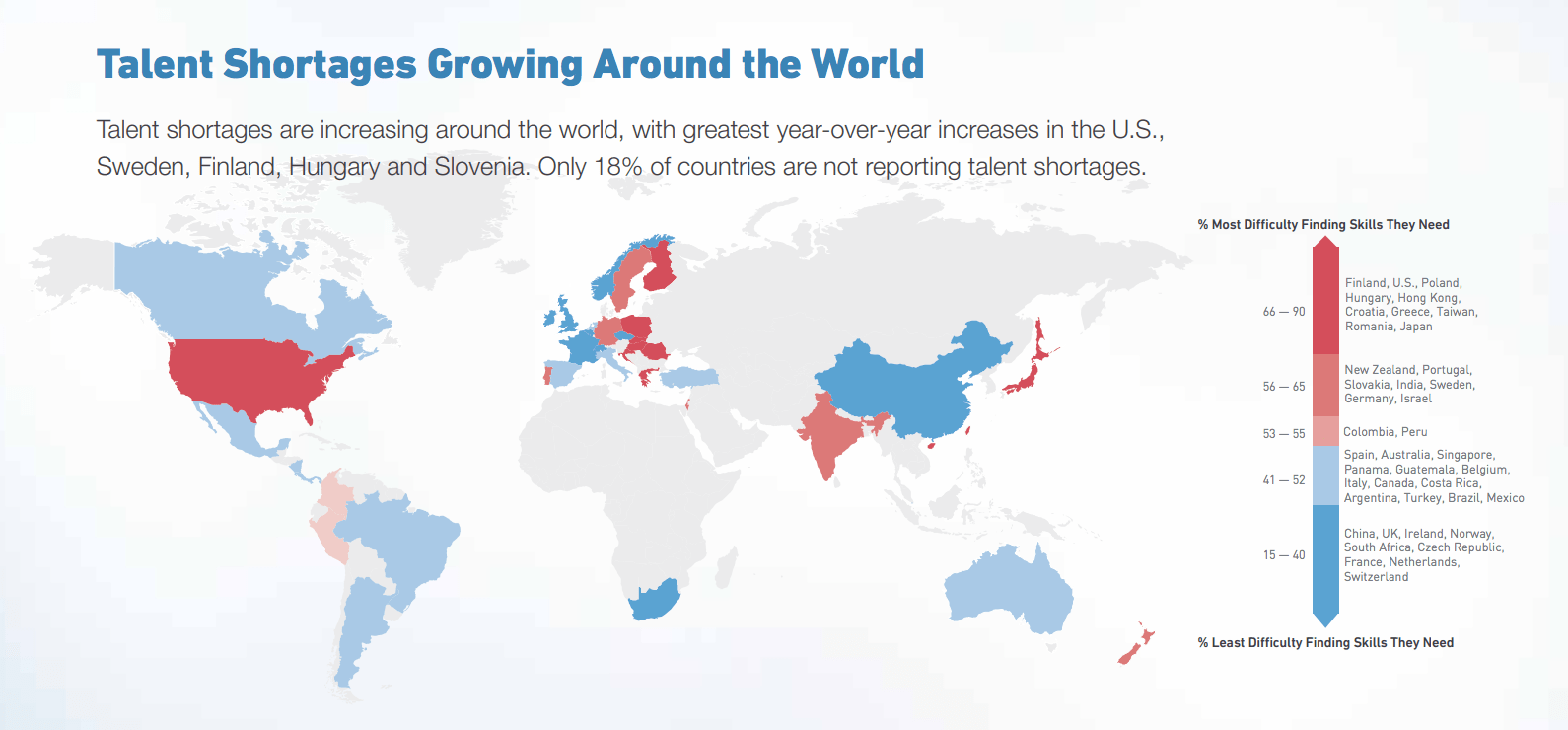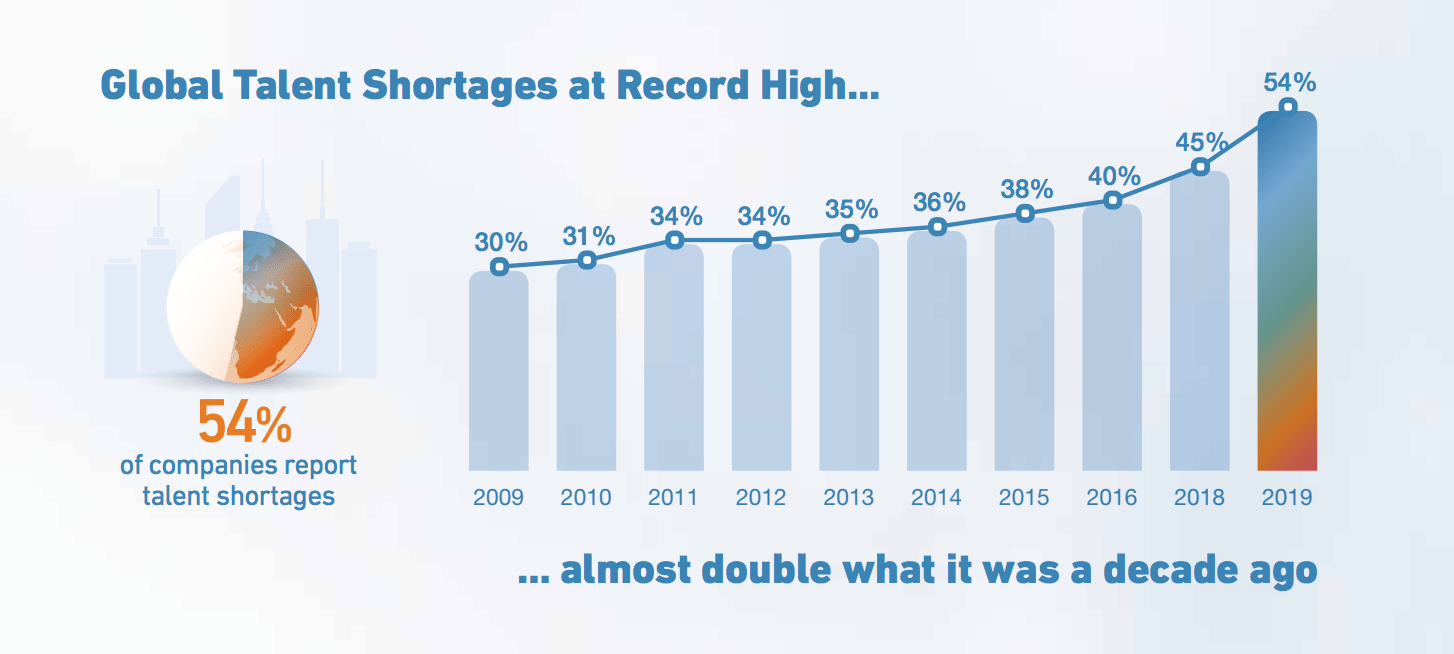The spark of automation in recent years, backed by economic growth and innovation, significantly impacted the job market and caused, paradoxically, both job loss and talent shortage. Those businesses in need of tech talent faced the biggest challenge to growing fast and efficiently in the industry, considering their lack of software engineers and high competition on the market.
As per a Harvey Nash Group report survey of 3000 tech leaders, 67% acknowledged a tech talent shortage. In addition, the increasing demand for new technologies with the outbreak of COVID-19 fueled the problem of finding new talent and amplified the talent crunch.
The widening gap between tech talent supply vs. market demand to fill those positions is disconcerting. If this bad situation continues to worsen, it will become even more difficult for businesses to overcome the issue.
Table of Contents
What creates demand for a job increase in the tech market?
The pandemic has accelerated the adoption of digital technologies by several years—in developed Asia, the leap is ten years. Remarkably, this all happened in a span of a few months.
- The rapid shift in customer interactions toward online channels prompted businesses to go digital and adjust workflows. More people started making purchases and receiving services online than ever before. The pandemic also influenced the number of cloud workloads. Almost 92% of organizations have increased the cloud workloads during the digitalization process.
- The rise of automation and AI stimulates economic growth, but 75 million to 375 million people may need to hone their area of expertise or upgrade their skills to perform new tasks. This trend created a demand for software development that can produce 20 million to 50 million jobs globally by 2030.
- One of the reasons for higher job demand is changing demographics. Most developing countries are growing their labor force and will experience a steady rise through at least 2030. These countries can start benefiting from job creation and innovation right now.
All in all, due to digital trends, the need for qualified computer science specialists has increased.
The shortage of top-notch tech talent worldwide.
A worldwide tech-talent shortage will continue to increase in the upcoming years. According to Korn Ferry, there will be a shortage of 85.2 million competent workers by 2030, resulting in lost revenue opportunities totaling $8.452 trillion—in tech alone. The US could lose out on $162 billion worth of revenues annually unless it finds skilled IT talent. What’s more India and Latin America could very well surpass the US with the number of IT professionals and become the next tech leaders with more than 1 billion tech workers.

There are increasingly more job openings than qualified people to fill them. For example, there will be 1.4 million computer science-related jobs available, but only 400,000 computer science graduates to fill those roles. Most of the baby boomers will have retired by 2030—that demographic alone will be the cause a shortage of a 545K software developers by 2026.

The US Bureau of Labor Statistics states that the employment of software engineers is going to grow 22% by 2029, compared to 5% of other occupations.
Issues employers are facing when it comes to the recruitment of software developers
Lack of Experience
By now, we are well aware of the lack of development talent in the tech industry. However, the top challenge recruiters face during the hiring process of software developers or other programming jobs is a lack of skilled talent. Hiring inexperienced graduates, The industry cannot expect high-quality work from inexperienced graduates.
The lack of proper experience and the shortage of software engineers, coders, developers, and other tech talents, pushed organizations to look beyond in-house boundaries to address the high level of demand, especially while hiring for specialized professions.
Lack of Technical Skills
The lack of experience is accompanied by a lack of the proper skillset during the hiring process. Despite the growing number of IT graduates, recruiters find it difficult to find the right hire.
Not every software graduate has the relevant experience—and even if they did—not everyone has the right skills to match the job description. Therefore, giving assessment tests to weed out poor candidates and conducting secondary and even tertiary interviews will not guarantee filling a position with the right person.
Lack of Formal Education
What bothers recruiters in the United States is that 51% of US high schools are certified to offer AP computer science, but only one in eight high schools offers the program. As a result, there are many self-taught software developers without any formal education or computer science degree and an increasing number of Bootcamp graduates.
Even though this can help fill the talent shortage, there is no assurance that they will qualify for those available tech positions.
High Salary Demands
The talent shortage in software development caused an increase in rates. The average national salary in the US is over $110,000 and will increase with higher demand. Tech giants such as Microsoft, IBM, or Amazon can easily hire top-notch developers because they can afford to pay a developer their asking salary. However, for an early-stage startup or a small business, paying over-market salaries because of high demand is not feasible and certainly not sustainable for the long term.
Solutions that companies are taking for the tech talent shortage
- Training. Training existing and new employees is the best way to address the issue of poor skillsets. The savviest companies are training talent themselves by incentivizing and recruiting high schoolers through in-house schools, coding boot camps, or competitions. In-house and out-house training offers valuable expertise to improve the skillsets and competencies of employees to hone their technical and soft skills to meet or exceed industry standards.
- Searching for talent in-house. Many organizations train existing employees who have the potential to fill a void in the talent gap. Training prepares them for a new challenging in-house role, although it can also be a problem-solving strategy for the company. This tactic allows them to fill in-house positions by training them before transferring them to a new department. That also acts as a retention strategy that can ease skill shortages.
- Reducing time to hire. Streamlining the hiring process can reduce the overall time-to-hire. This can only be achieved with a pre-defined recruitment guideline. This factor can impact a company’s reputation among candidates and help them stand out from their competitors.
- Outsourcing. Leveraging offshore, nearshore, and remote talent pools is the most promising way to balance the talent shortage, especially when a company demands highly-skilled personnel but it’s having a difficult time hiring a qualified candidate locally. Outsourcing provides access to the global talent pool and saves time and money. This works effectively to counter-strike the high turnover in the IT industry. Companies based in California, however, should familiarize themselves with the important regulations regarding freelancer compensation, such as the California Assembly Bill (AB5).
Browse 500+ Dev Teams Available for Hire
Best countries to outsource a software development process
Amid the COVID-19 crisis, financial crunch, and shortage of software developers within the US, outsourcing is the answer to the lack of development talent. It is the best solution for startups, small, mid, and large-sized enterprises.
As per the Deloitte Global Outsourcing Survey 2021, disruptive outsourcing led by cloud and automation technologies focused on performance improvement and cost reduction.
This cost-efficient strategy hopes to fill the tech-talent gap and provide access to world-class technologies and global talent.
So, with this in mind, let’s explore some of the top countries for software development outsourcing in 2022.
1. Brazil
With more than half a million developers and over 6 million English speakers, Brazil is a newcomer that is fast becoming the main hub for cost-effective software development services. Some top reasons that have made Brazil one of the hottest outsourcing destinations are its plethora of trusted software providers available at affordable prices and a significant talent pool of software engineers, developers, and programmers with rich professional expertise in Python, .NET, and other technologies. Brazil has the largest amount of Java developers in the world. Brazil’s time zone makes it convenient for collaborating with North American and European customers as the country is only three hours behind the United Kingdom and an hour ahead of the United States.
Developer Rates – $45-$70/hour
Time Zone – GMT -3
2. Mexico
This perfectly situated country is the potential go-to destination for businesses looking for a highly skilled talent pool at an affordable price. According to Stack Overflow, Mexico is home to 223,000 software developers, and with the constant increase of IT specialists, the country provides access to a huge array of developers. Its developers also provide expertise in Agile development, Blockchain, IoT, and Analytics. Among the many reasons to choose Mexico for outsourcing your software is the perfectly aligned time zone with the United States, the countries share a border, and it has a large English-speaking population.
Developer Rates – $40-$80/hour
Skill Value Rank – 2nd (Best Developers)
Time Zone – GMT -6
3. Ukraine
Located in Eastern Europe, Ukraine is one of the top outsourcing software development destinations in the world. Ukraine is the top contender because 80% of the IT community has a high level of English proficiency and its time zone overlaps with the US and the UK, facilitating convenient communication and cooperation. With around 200,000 professional developers and IT specialists, Ukraine is famous for its high number of C++ programmers. It also offers expertise in many major programming languages, including JavaScript, Python, PHP, and NodeJS.
Many foreign clients may be intimidated by the fact that the country is at war and their developers are working there. Companies and employers are concerned about whether it is safe and if production will suffer. However, before the war started, IT companies preemptively moved their teams to Western Ukraine or abroad, allowing them to continue working seamlessly. Therefore, Ukrainian developers continue to be motivated to work efficiently to provide for their families and support the country’s economy.
Ukrainian software developers have been in high demand for companies looking to outsource for quite some time.
Price – $55-$89/hour.
Time Zone – GMT +2
4. Poland
Poland is known as a country with a highly-advanced IT infrastructure, fast and affordable (one of the cheapest in the world) mobile internet, and most importantly, a highly-skilled, English-speaking talent pool. It is growing to be the outsourcing giant of Eastern Europe—and the world. While PHP is the widely employed programming language in Poland, the popularity of Java, Python, Ruby, Shell, and .NET Framework is equally high. Polish software developers are among the most qualified, experienced, and the world’s best in terms of coding experience.
Moreover, if you are on the hunt for a software development team skilled in Agile methodologies, Polish teams are well-versed. All these factors make Poland a perfect destination for outsourcing software development.
Price – $45–$90/hour.
Time Zone – GMT +2.
What are the benefits of outsourcing software development with YouTeam?
No matter a business’s size or experience—startup or established player—YouTeam acts as a bridge between the company and a top-notch software engineer. It offers many advantages that can benefit companies in the long run.
- YouTeam is a marketplace with a huge database of world-class talent that has been added to our broad pool of professionals from top development agencies in Eastern Europe and Latin America.
- YouTeam helps employers source candidates from meticulously vetted software development firms. The process of matching candidates takes around 48 hours. Because we provide companies only with the profiles of developers who are ready to start new projects, the hiring process can be completed within one week. If the sourced talent or new hires don’t meet company expectations, we provide a replacement at no extra cost.
Wrap up
The gap between available job openings and the tech talent shortage visibly widened with the rise of automation and digital transformation due to the impact of COVID-19. IT outsourcing is an excellent solution to transform your businesses digitally by automating your business processes. It helps to reduce risk and saves time and money. Now you can focus on your core business needs rather than managing an in-house software development team. With YouTeam, you are just a click away from finding and hiring the right talent.







